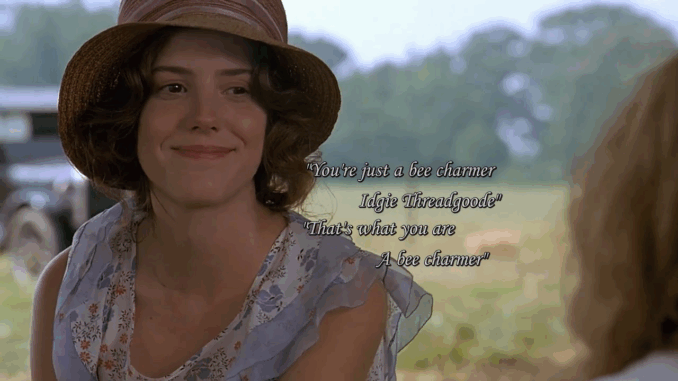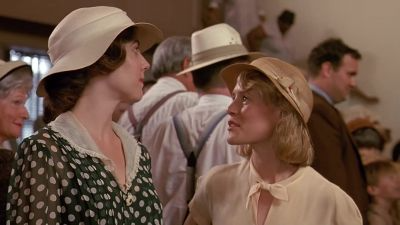
A Gift Born of Memory
In Fried Green Tomatoes, some of the most powerful moments are small, quiet gestures that hold deep emotional weight. One such moment occurs when Idgie brings Ruth a simple jar of honey—harvested from wild hives, wrapped with care, and delivered with silent significance. This is more than a food offering. It is a symbol of healing, remembrance, and emotional intimacy.
The scene is short, subtle, and easy to overlook, but it carries the emotional residue of the past and the quiet hope of a future. It’s Idgie’s way of saying what she cannot yet say aloud: I remember. I care. I am still here.
The Beehive as a Place of Courage
The origin of the honey stretches back to an earlier, iconic scene in the film: young Idgie fearlessly retrieving honeycomb from a tree swarming with bees. She climbs barefoot, daring and wild, reaching into the buzzing hive with bare hands. The scene is a snapshot of Idgie’s character—rebellious, brave, and fiercely alive.
When she returns with the dripping comb to Ruth, who is still new to Whistle Stop and learning who Idgie is, there’s a playful spark between them. It is the beginning of their deep connection, captured in a gesture that’s equal parts daredevil bravado and vulnerable offering.
Years later, the honey returns—this time in a jar, no longer raw, but preserved. The transformation mirrors Idgie herself: still wild at heart, but more reflective, more capable of tenderness. This jar of honey becomes a time capsule of that early connection. A tangible memory.
Ruth’s Illness and the Gentle Gesture

By the time Idgie brings the honey again, Ruth is gravely ill. The once vibrant woman is now frail and fading. There’s a stillness in the room, the kind that comes when words no longer suffice. Idgie, who has never been one for sermons or sentimentality, walks in with the jar.
She doesn’t announce it. She doesn’t explain. She simply places it on the table near Ruth, like a prayer left at a shrine.
This honey is not medicine. It won’t save Ruth. But it is everything else: a remembrance of their youth, a symbol of Idgie’s enduring love, a sweetness that defies the bitterness of death.
Love Without Words
What makes this scene especially powerful is its restraint. There are no dramatic speeches, no tearful confessions. Just a quiet exchange of presence. Ruth sees the jar, understands its significance, and offers the smallest smile. That smile is enough.
For Idgie, who has always loved through action rather than language, the honey is the closest she can come to saying goodbye. Or perhaps, she’s saying: You’re still with me. Just like then.
In the silence between them, decades of shared history echo. The bee tree, the café, the laughter, the pain—they all exist in that one glass jar.
Honey as Symbol: Preservation, Nourishment, Memory
Honey, by nature, is one of the few substances that never spoils. It endures. It preserves. It nourishes. In this context, it becomes the perfect metaphor for Idgie and Ruth’s relationship. Though Ruth’s body is failing, the love they’ve built endures.
The honey also symbolizes sweetness that comes from pain. Bees sting to protect their hives. To gather honey is to risk suffering. Idgie has endured much in her life—loss, judgment, isolation—but she has never stopped gathering sweetness where she can find it.
By sharing that sweetness with Ruth, she honors not only their past but her own capacity to still find beauty in a world that often hurts.
A Farewell Without Goodbye
In many ways, the honey jar is Idgie’s farewell. She will not say the word “goodbye.” That would be too final, too devastating. But she offers the honey like a final thread tying Ruth to life, to memory, to her.
It is a gesture that requires no reply. Idgie isn’t asking for recognition or thanks. She’s simply giving. And Ruth, who understands Idgie better than anyone, receives it not with words, but with knowing.
There is grace in this moment. A kind of quiet closure. Love at its most distilled.
A Scene That Echoes Beyond the Film
This scene may be brief, but it resonates long after the credits roll. It captures the essence of Fried Green Tomatoes—a story about chosen family, enduring friendship, and the small acts that define great love.
The jar of honey becomes a symbol for everything unspoken between two women who have lived and loved on their own terms. In a world that often sought to deny or diminish them, this moment is defiant in its intimacy.
Conclusion: The Bittersweet Gift
In the end, the jar of honey stands as one of the most poetic elements in Fried Green Tomatoes. It is a gift not only for Ruth, but for the audience—a reminder that love can be quiet, that memory can be preserved, and that sweetness can still be found even in life’s darkest corners.
Idgie’s offering is not just of honey, but of history. It is the taste of laughter by the bee tree, of meals shared at the Whistle Stop Café, of lives intertwined against all odds.
In giving it, she gives everything.
